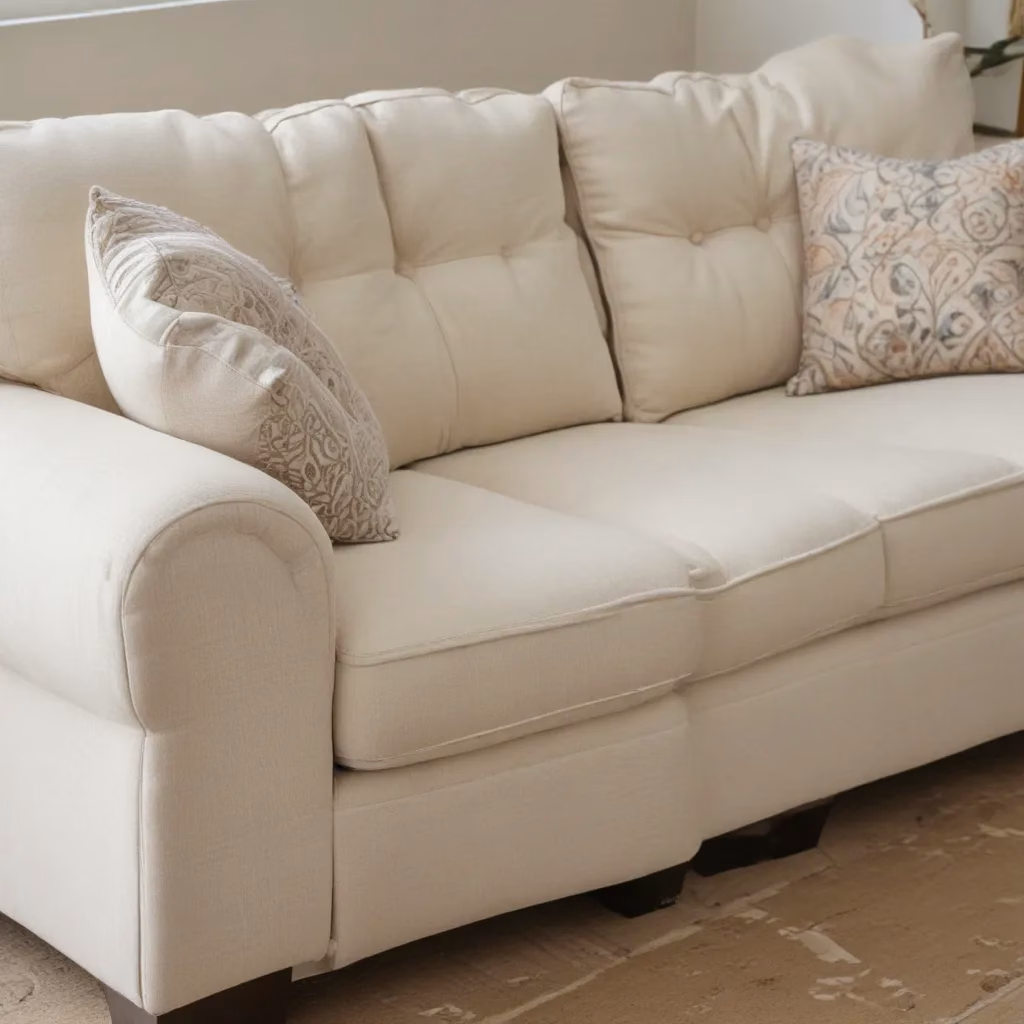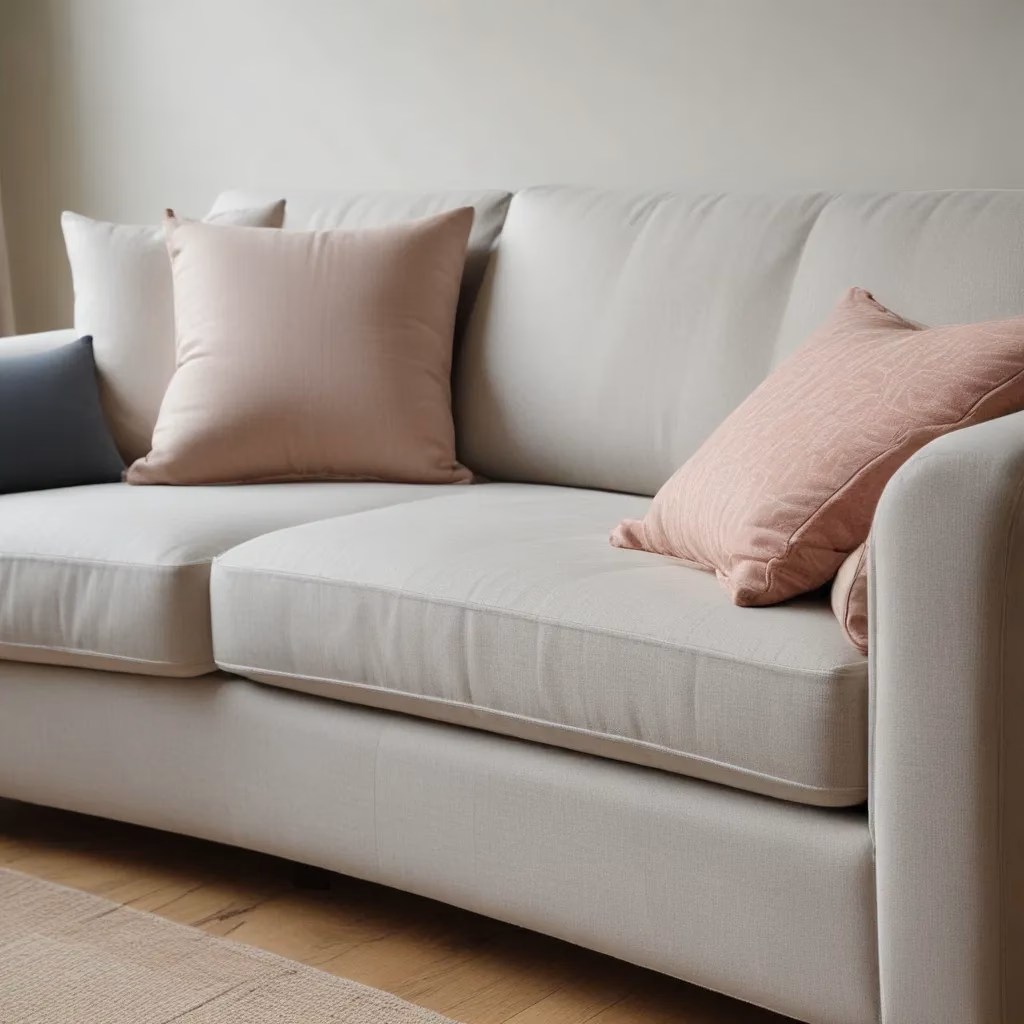
Living in a small home can present unique decorating challenges, but with the right furniture and layout strategies, you can create a comfortable and functional living space. As an experienced furniture consultant and interior design writer, I’m here to share my top tips for maximizing space and style in compact living areas.
Now, this might seem counterintuitive…
Sofa Selection for Small Spaces
When it comes to furnishing a small home, the sofa is often the focal point of the living room. Choosing the right size and shape can make all the difference in creating a cohesive, uncluttered aesthetic.
Choosing the Right Size and Shape
The key is to select a sofa that fits the dimensions of your room without overwhelming the space. Measure the available floor area carefully and opt for a compact model that leaves ample walking room around it. Loveseat-sized sofas (typically 60-72 inches wide) or settees (48-60 inches) are excellent choices for small living rooms.
Look for sofa designs with slim arms and a low profile to help visually “open up” the room. Rounded or angled silhouettes can also make a space feel less boxy. Avoid bulky, overstuffed pieces that may make the room feel cramped.
Compact Sofa Models and Dimensions
When shopping for a small-space sofa, pay close attention to the dimensions. A standard full-size sofa is usually 84-96 inches wide, while a loveseat ranges from 60-72 inches. Compact models like apartment-sized sofas or studio sofas are typically 72 inches or less.
Some space-saving sofa options to consider include:
– Sectional sofas with chaise lounges or armless designs (6-8 feet wide)
– Sleeper sofas with built-in queen or full-size mattresses
– Futons or daybeds that double as seating and sleeping surfaces
Be sure to measure your entryways and stairwells to double-check that your chosen sofa can be easily maneuvered into the room.
Multipurpose Furniture Solutions
In a small home, furniture with hidden storage can be a game-changer. Look for sofas with lift-top or flip-up seats that reveal spacious compartments for stashing extra linens, throw pillows, or other living room essentials. Ottomans and storage benches are also excellent multifunctional pieces.
Modular sofas with movable chaise sections or armless units allow you to rearrange the layout to suit your needs. This flexibility can be especially useful for open-concept spaces or homes with fluid living areas.
Upholstery Fabric Essentials
The fabric you choose for your sofa can have a big impact on the overall look and feel of your small living space. Focus on durable, easy-to-clean materials that can withstand daily use.
Durable and Stain-Resistant Fabrics
In compact homes, sofa upholstery needs to be both stylish and resilient. Microfiber, crypton, and performance fabrics are excellent choices, as they are highly resistant to spills, stains, and everyday wear and tear.
Leather and faux leather are also smart options, as they can be easily wiped clean. However, they may feel a bit heavier and more formal in a small room.
Texture and Pattern Considerations
To add visual interest without overwhelming the space, look for sofa upholstery with subtle textures or small-scale patterns. Woven fabrics, linen-blends, and low-profile velvets can lend a cozy, inviting feel. Avoid large, bold prints, which can make a room feel cluttered.
Cleaning and Maintenance Tips
No matter which sofa fabric you choose, follow the manufacturer’s care instructions to keep it looking its best. Lightly vacuum or brush the upholstery regularly to remove dust and debris. Spot-clean spills immediately with a mild soap and water solution.
For deeper cleaning, consider hiring a professional upholstery cleaner every 12-18 months to restore the sofa’s pristine appearance.
Living Room Layout Strategies
Arranging your small living room furniture in a way that maximizes flow and functionality can make a big difference in how the space feels.
Space-Saving Furniture Arrangements
When working with limited square footage, consider a sectional sofa or L-shaped configuration to maximize seating while minimizing the footprint. Position the sofa against a wall or in a corner, and add any additional chairs or accent pieces around it.
Floating furniture, where pieces are not flush against the walls, can also help create a more open, airy feel. Just be sure to leave enough room for easy movement around the space.
Maximizing Natural Light and Airflow
Positioning your sofa and other living room furniture to take advantage of natural light can instantly make a small space feel brighter and more expansive. Avoid blocking windows or doorways, which can restrict airflow and make the room feel enclosed.
If your living area lacks abundant natural light, use strategically placed task lighting and ambient lighting to create a welcoming atmosphere. Wall-mounted lamps, recessed lighting, and floor lamps with adjustable brightness can all help illuminate dark corners.
Multifunctional Pieces and Dual-Purpose Designs
In a small home, every inch of space counts. Incorporate furniture with hidden storage, such as ottomans and coffee tables with interior compartments, to keep clutter out of sight.
Nesting tables or console tables with fold-out extensions can double as both a display surface and a dining or work area when needed. Modular sectionals with movable chaise units also offer flexibility in arranging the room.
Styling for Comfort and Aesthetics
Once you’ve selected the right sofa and arranged your living room furniture, turn your attention to the details that will make the space truly feel like home.
Layering Textiles and Accessories
Plush throw pillows, cozy blankets, and area rugs can instantly warm up a small living area and add visual interest. Choose fabrics and patterns that complement your sofa upholstery and tie the room together.
Incorporate a mix of textures, such as velvet, wool, and cotton, to create depth and visual appeal. Just be mindful of scale, as large, bulky accessories can overwhelm a compact room.
Incorporating Cozy Lighting
Proper lighting is key in a small living space. In addition to overhead fixtures, use floor lamps and table lamps to create a warm, inviting ambiance. Dimmers allow you to adjust the brightness to suit your mood or activity.
Avoid harsh, glaring light sources, which can make a room feel smaller. Instead, opt for soft, diffused lighting that flatters the space.
Balancing Form and Function
When styling your small living room, strike a balance between form and function. While aesthetics are important, double-check that that your décor choices also provide practical benefits, such as ample storage, comfortable seating, and easy traffic flow.
Remember, a well-designed small space should feel intentional, not cluttered. Periodically assess your living room and make adjustments to double-check that it continues to meet your needs and reflects your personal style.
Furniture Buying Guides
Purchasing the right sofa and living room furniture for a small home requires careful consideration. Here are a few tips to help you navigate the process.
Measuring for the Perfect Fit
Before shopping, measure your living room dimensions, including doorframes, hallways, and any other tight spaces the furniture will need to navigate. This will double-check that you choose pieces that not only fit the room but can also be easily maneuvered into the space.
Pay close attention to sofa measurements, including width, depth, and height, to find a model that suits your needs. Don’t forget to factor in any additional clearance required for walking paths or opening drawers and doors.
Shopping for Quality and Value
When investing in furniture for a small home, look for well-made, durable pieces that will stand the test of time. Hardwood frames, high-density foam cushions, and reinforced joints are all signs of quality construction.
Compare prices and consider the long-term value of your purchase. While budget-friendly options may seem appealing, cheaper sofas may not offer the same level of comfort or longevity. Weigh your needs against your budget to find the best balance of quality and affordability.
Navigating Online and In-Store Options
Both online and in-store furniture shopping have their advantages. Online retailers often offer a wider selection and the convenience of home delivery, while in-person stores allow you to physically test out sofas and other pieces.
Whenever possible, visit a showroom to experience the sofa’s comfort and quality firsthand. This can be especially helpful for evaluating sleeper sofas or sectionals, which may have special features or mechanisms you’ll want to try out.
No matter where you shop, be sure to read product descriptions and reviews carefully. This will help you make an informed decision and find the best sofa for your small living space.
Living in a compact home doesn’t have to mean sacrificing comfort or style. By carefully selecting the right sofa, upholstery fabrics, and furniture layout, you can create a cozy, functional living room that makes the most of your available square footage. And don’t forget to accessorize with thoughtful lighting and textiles to bring it all together. With these space-saving solutions from SofaSpectacular, you can enjoy the compact comfort you crave in your small home.
Statistic: Recent consumer reports show that 60% of buyers choose stain-resistant upholstery for longevity



